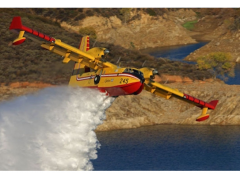CL-215, CL-215T and CL-415
The CL-215 can be traced back to two early projects by Canadair, the CL-43 and CL-204. The CL-43 was conceived as a logistics aircraft and was based on the design of the Canadian Vickers-built 369 Canso (a variant of the Consolidated PBY Catalina). Arising from an earlier 1960s research study at the company, the original concept was for a twin-engined floatplane transport, that was altered into a "firefighter" as a result of a request by forestry officials in the Quebec Service Aérien (Quebec Government Air Service) for a more effective way of delivering water to forest fires. The 1962 preliminary design, the CL-204, was a purpose-designed water bomber that evolved into an amphibian flying boat configuration, powered by two shoulder-mounted 2,100 hp (1,566 kW) Pratt & Whitney R-2800 piston engines. The definitive design known as the CL-215 received a program go-ahead in February 1966 with its maiden flight on 23 October 1967. The first delivery was to the French civil protection agency (Sécurité Civile, then known as Protection Civile) in June 1969. Production of CL-215s progressed through five series ending in 1990.
In 1987, the CL-215T was announced, with improvements in handling brought about by design changes to the wings and empennage, and more powerful Pratt & Whitney turboprop engines. Originally the follow-up CL-215T was to be a simple turboprop-powered development of the CL-215, and Canadair converted two aircraft in 1989 to act as development aircraft. The first of these flew on 8 June 1989. Retrofit kits for CL-215s to the new standard are offered, but Canadair elected not to build new CL-215Ts and instead developed the CL-415.
In 1987, following market trends towards more efficient, powerful and reliable turboprop powerplants, Canadair undertook the task of retrofitting 17 CL-215 airframes with the Pratt & Whitney Canada PW123AF engines, providing a 15% power increase over the original piston engines as well as enhanced reliability and safety. The retrofitted aircraft were designated CL-215T and also featured many aerodynamic and systems improvements including powered flight controls, cockpit air conditioning, as well as upgraded electrical and avionics systems. The most notable external features of the CL-215T retrofit were the aerodynamic additions to the wings and empennage.
based on the success of the CL-215, the company introduced the CL-415, a new-build production series beginning in 1993. The 415 has an updated cockpit, aerodynamics enhancements and changes to the water-release system as well, creating a modern firefighting amphibious flying boat for use in detecting and suppressing forest fires.
The 415 first flew on December 6, 1993, with the first deliveries in November 1994.[6] Orders from several countries soon followed. Derived from its predecessor's nickname, it acquired the name, "Super Scooper" in light of its greatly enhanced performance as a water bomber and fire suppresser. In recognition of its abilities, the aircraft was awarded the prestigious Batefuegos de oro (gold fire extinguisher). The award citation in part read "This is the most efficient tool for the aerial combat of forest fires, key to the organization of firefighting in a large number of countries. The continuous improvements to meet the needs of forest firefighting have made these aircraft the aerial means most in demand over more than 30 years."
Compared to the CL-215, the 415 has increased operating weight and speed, yielding improved productivity and performance. The 415 can scoop up to 6,140 litres (1350 Imperial gal or 1,620 US gal) of water from a nearby water source, mix it with a chemical foam if desired, and dro it on a fire without havin to return to base to refill its tanks. The 415 was specifically developed to provide the capability to deliver massive quantities of suppressant in quick response to fires. The aircraft is built for reliability and longevity, with use of corrosion-resistant materials. The new 415GR has higher operating weights while the Bombardier 415 multi-role is available for use in a paramilitary search and rescue role and utility transport.
- See more at: http://www.vikingair.com/viking-aircraft/cl-215-cl-215t-and-cl-415#sthash.QphaRsgW.dpuf













